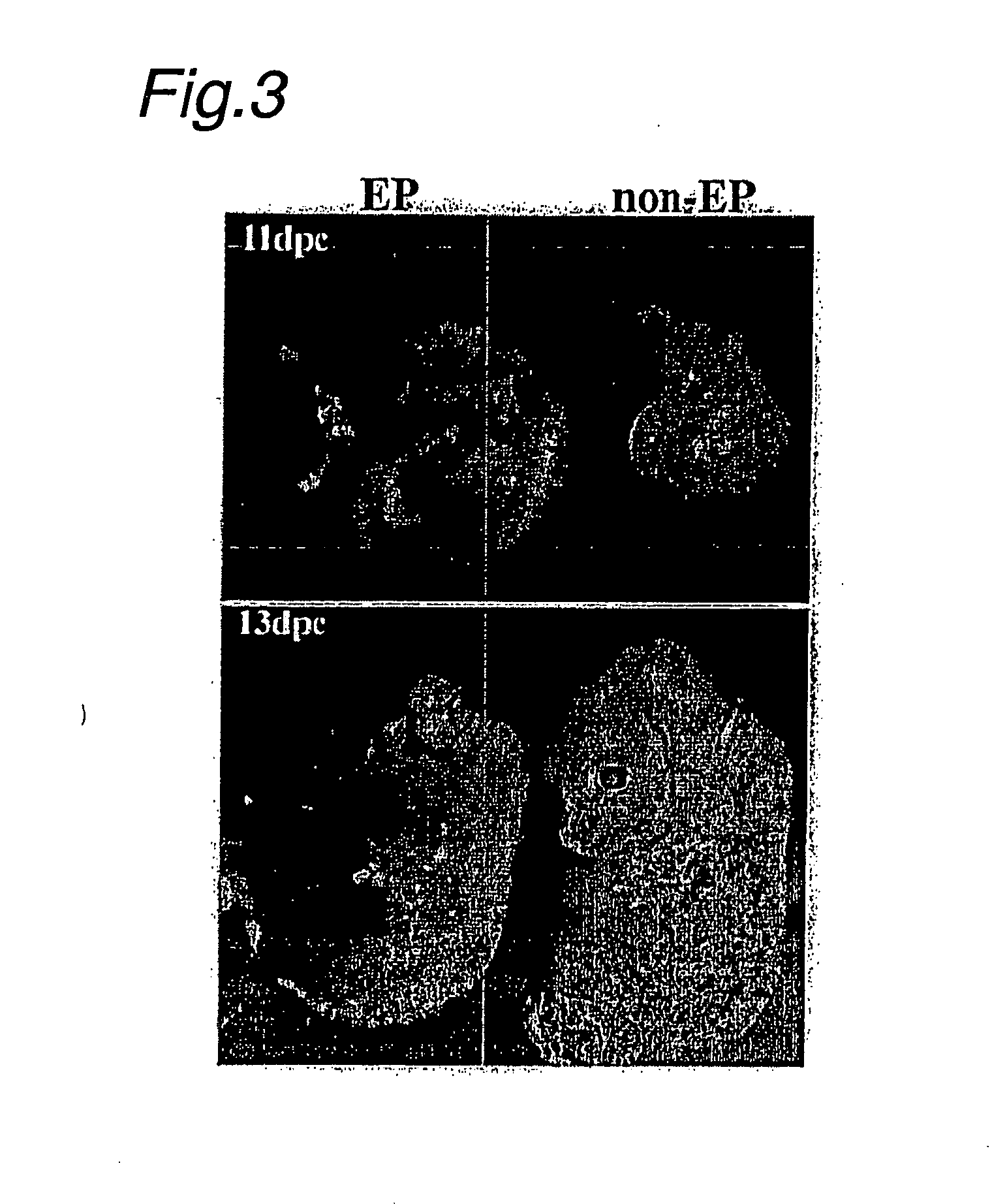Neuronal cells obtained by electric pulse treatment of es cells
a technology of es cells and neuronal cells, which is applied in the direction of antibacterial agents, extracellular fluid disorders, metabolic disorders, etc., can solve the problems of inability to isolate two processes, inability to re-create functional organs in ex vivo culture, and much is still unknown about the molecular mechanisms of early neural development in mammals. , to achieve the effect of strong tendency to move towards differentiation
- Summary
- Abstract
- Description
- Claims
- Application Information
AI Technical Summary
Benefits of technology
Problems solved by technology
Method used
Image
Examples
example 1
Cell Fate Determination of Electric Pulse-Treated Cells in Culture
[0118] (1) The effects of intracellular and extracellular ion balance on differentiation fate were tested by application of electricity. An EB was first prepared by known methods as described below, and an electric pulse was applied to the EB with electrodes.
[0119] First, embryonic stem cells expressing Venus were isolated by electroporation of R1 ES cells (obtained from Prof. Andreas Nagy at Mount Sinai Hospital (Toronto, Canada)) expressing the Venus protein (obtained from Prof. Atsushi Miyawaki of the Institute of Physical and Chemical Research Brain Science Institute) induced by the CAGGS promoter (obtained from Prof. Junichi Miyazaki of Osaka University) (Non-Patent Publications 9 and 18). An embryoid body was prepared by culturing ES cells using DMEM comprising 10% FCS in an adhesion-proof bacterial Petri dish (Nunc).
[0120]“Venus” is a variant of EYFP, which is itself a variant form of GFP (green fluorescent ...
example 2
Neuron Contribution of Electric Pulse-Treated ES Cells to Embryos
[0129] (1) In the ex vivo experiment of Example 1, the resulting neuron precursor cells did not appear to have any responsiveness to growth factors. Treated and non-treated ES cells were injected into mouse embryos at various stages to test the biological ability of these cells.
[0130] Specifically, 10 V pulse-treated Venus-positive embryoid bodies (EBs) were dissociated for 3 minutes with trypsin-EDTA. The dissociated cells were injected into C57BL / 6 blastocysts. The resulting embryos were fixed with 0.05 M phosphoric acid buffer (pH 7.4) containing 4% formaldehyde at E11.5 or E13.5 for immunohistochemical purposes.
[0131] 12 embryos and 15 embryos were collected from injection into blastocysts of 10 V pulse-treated and untreated control cells, respectively. An ES cell line (Non-Patent Publication 9) with ubiquitous expression of Venus (EYFP derivative) was used to follow cell fates with fluorescence and / or GFP antib...
example 3
Formation of Adult Neuron Tissue
[0139] (1) Using adult injured spinal cord as the recipient, electric pulse-treated embryoid bodies were deliberately injected to determine whether electric pulse-treated embryoid bodies have the ability to contribute to neuron tissue (FIG. 6). The present invention offers new potential for recovery from motor dysfunction.
[0140] To create vertebral damaged mice, adult 129 SvEv mice were anesthetized with pentobarbital (50 mg / kg, ip.), and the spinal cord at the T13-L2 level was subjected to a weight-drop shock. 10 days later, Venus-positive embryoid bodies were transplanted into the shock injured mice. The embryoid bodies were injected into the damaged spinal cord at the L1 level. 20 days after transplantation, sections were treated for immunohistochemical purposes. All mice were maintained at the RIKEN-BSI animal facility in accordance with laboratory guidelines.
[0141] (2) As can be seen from the footprints in FIG. 9, all the injured mice who rece...
PUM
| Property | Measurement | Unit |
|---|---|---|
| power | aaaaa | aaaaa |
| power | aaaaa | aaaaa |
| power | aaaaa | aaaaa |
Abstract
Description
Claims
Application Information
 Login to View More
Login to View More - R&D
- Intellectual Property
- Life Sciences
- Materials
- Tech Scout
- Unparalleled Data Quality
- Higher Quality Content
- 60% Fewer Hallucinations
Browse by: Latest US Patents, China's latest patents, Technical Efficacy Thesaurus, Application Domain, Technology Topic, Popular Technical Reports.
© 2025 PatSnap. All rights reserved.Legal|Privacy policy|Modern Slavery Act Transparency Statement|Sitemap|About US| Contact US: help@patsnap.com



